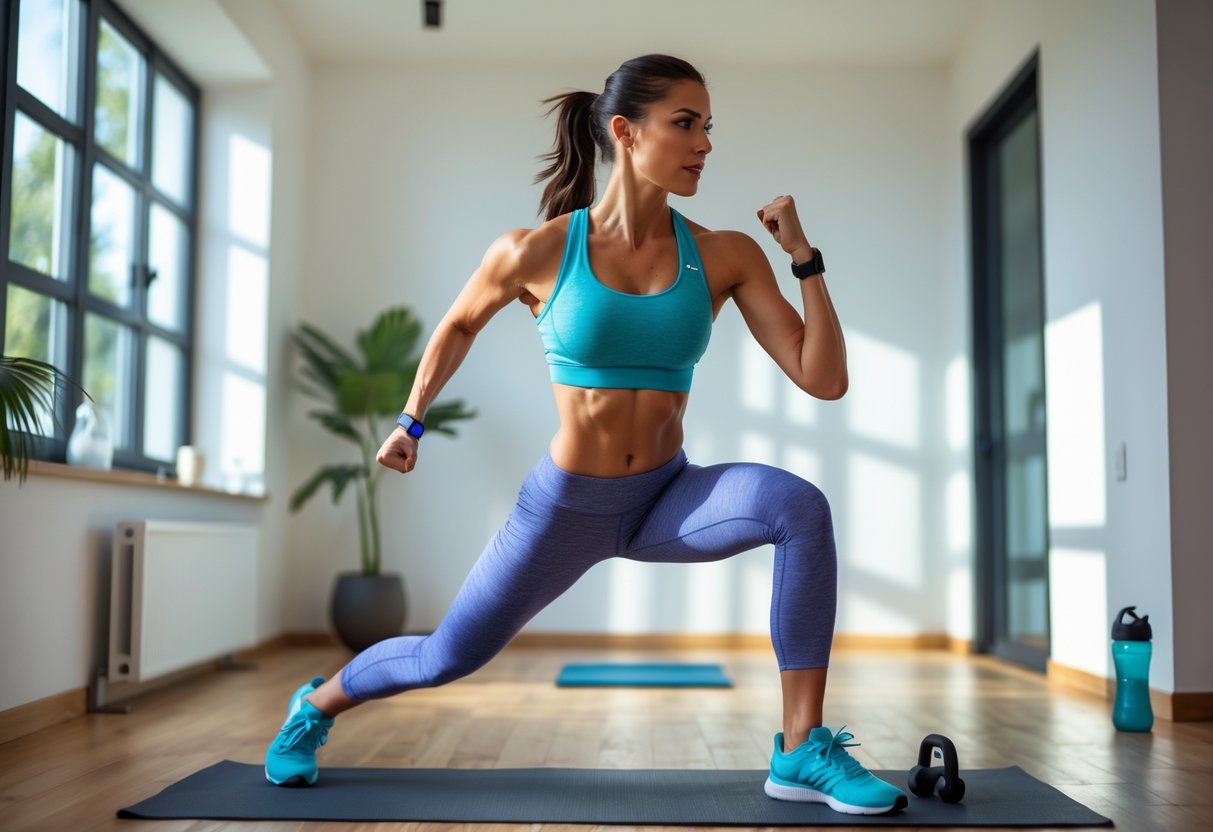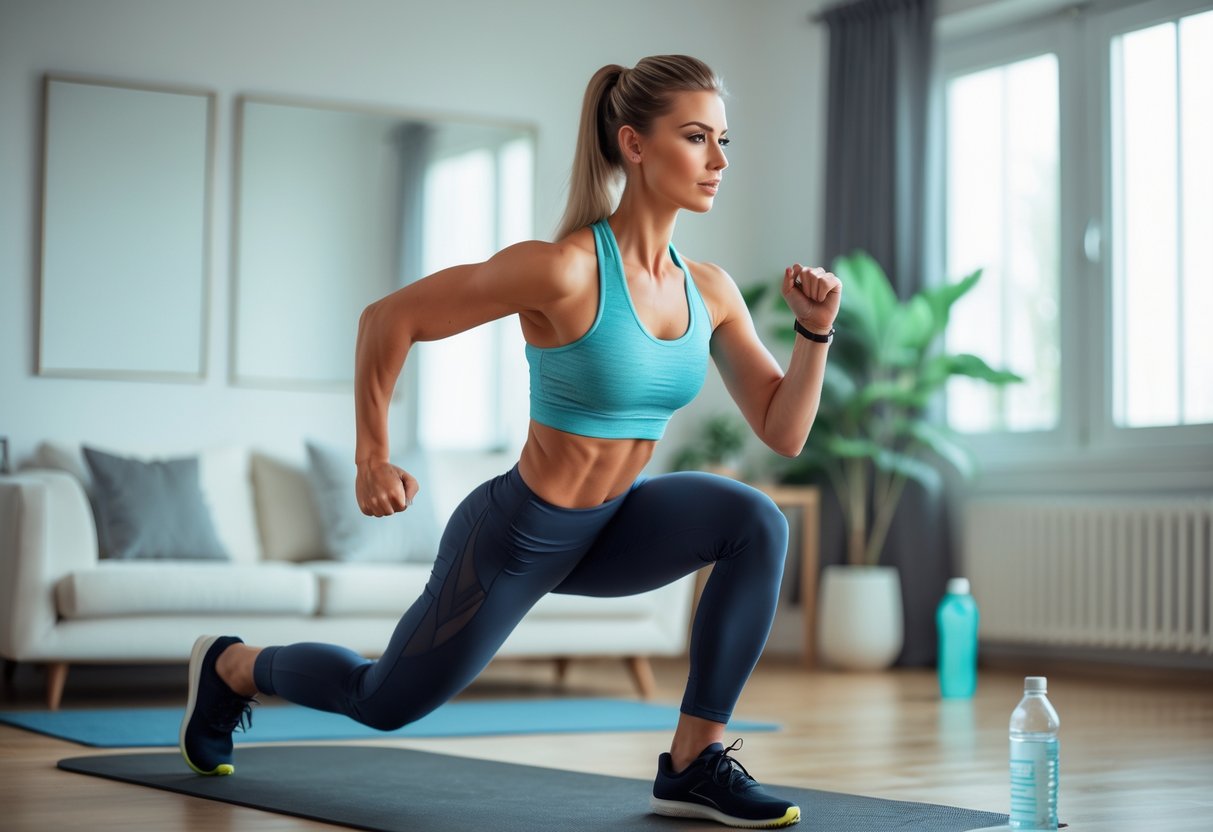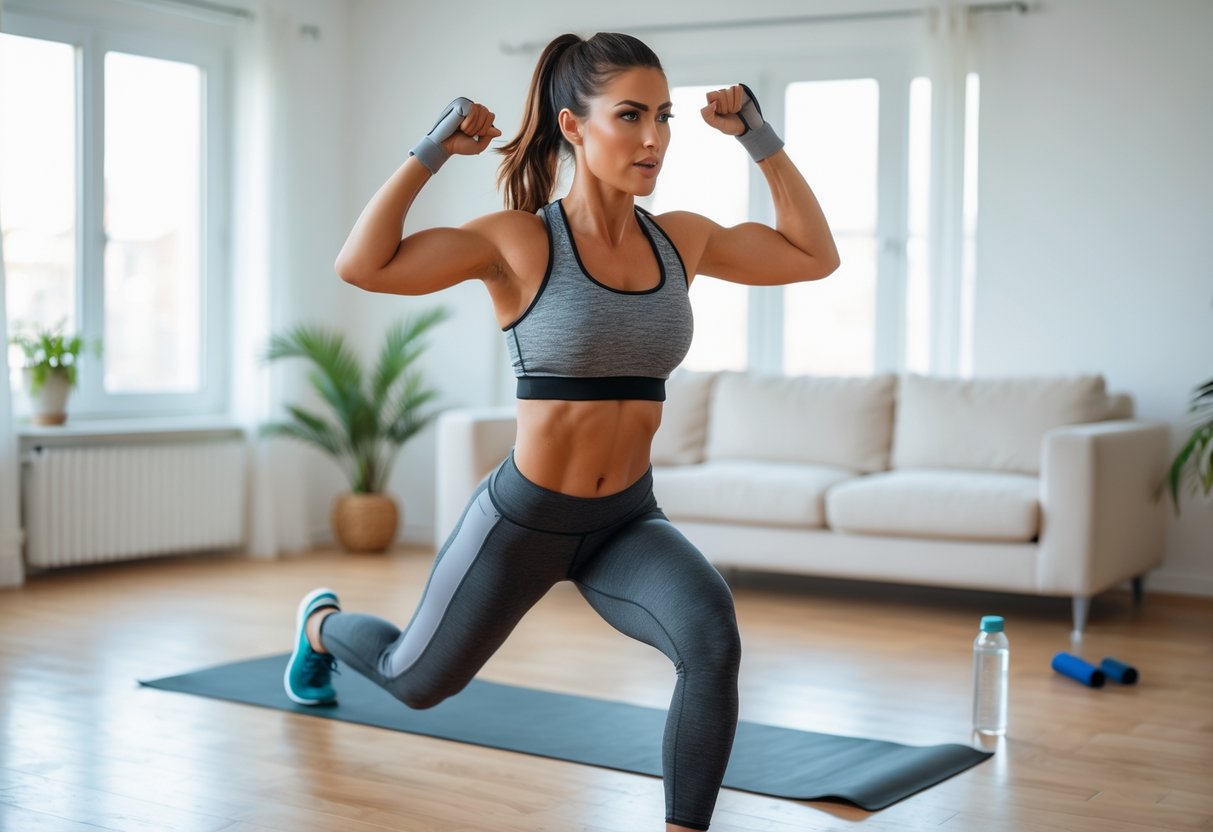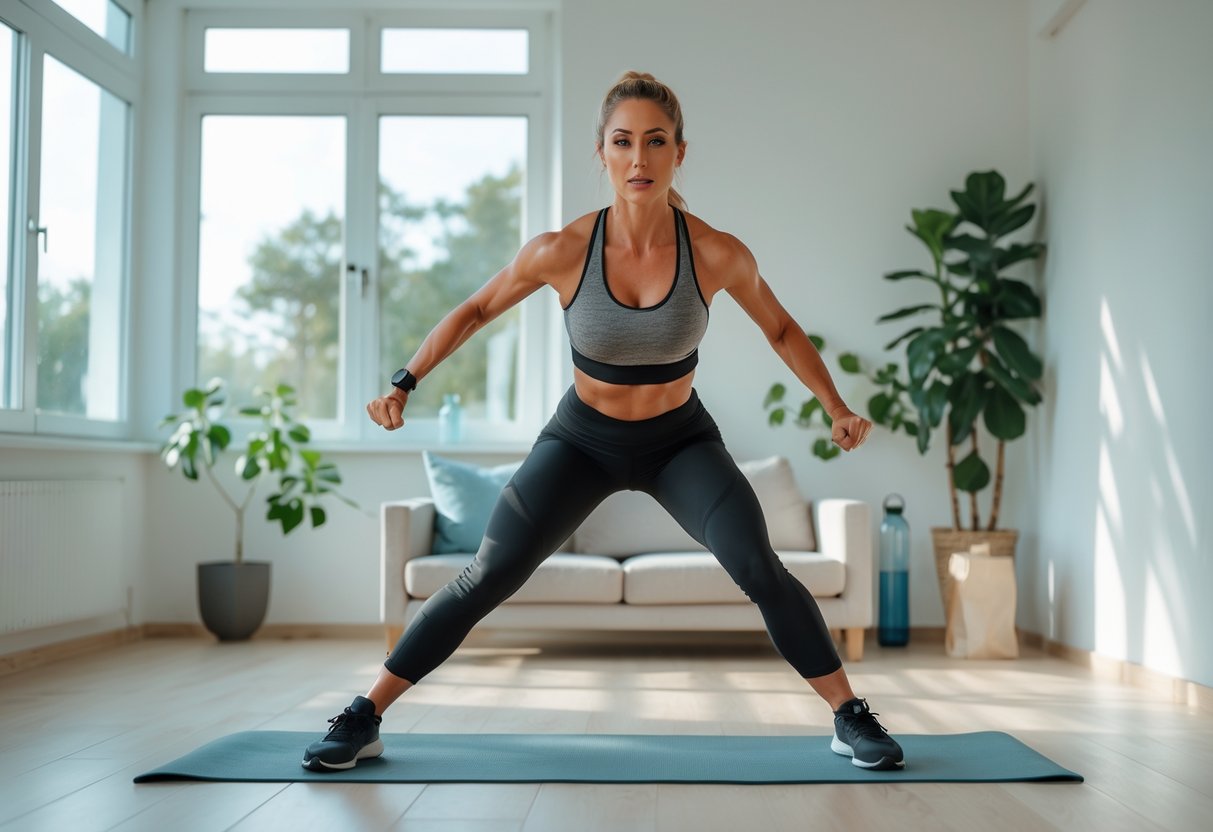HIIT Home Workout: Burn Fat Fast with Intense Bodyweight Routines for Rapid Results
This post may contain affiliate links. If you purchase through these links, I may earn a small commission at no extra cost to you. LEARN MORE.
Looking for a way to lose fat and build strength without leaving the house?
HIIT (High-Intensity Interval Training) home workouts use quick bursts of activity and short rests to push the body and burn calories in less time.
Anyone can do these intense, no-equipment routines to boost fat loss and increase fitness, right in their own living room.

Simple bodyweight moves like squats, lunges, and burpees make up many HIIT routines, so there’s no need to buy gear or go to the gym.
Each session can be changed to fit different fitness levels, making these exercises a good choice for beginners and advanced athletes.
Ready to amplify your fat-burning? Get a personalized keto meal plan to fuel your HIIT results with Keto Creator today.
Key Takeaways
- HIIT uses quick, intense exercises to burn fat fast at home.
- Most routines need little or no equipment and are easy to adapt.
- Proper preparation, form, and rest help prevent injury and improve results.
What Is HIIT and How Does It Work?

High-Intensity Interval Training (HIIT) uses short bursts of hard effort mixed with brief rest periods.
This approach helps people burn more fat, boost endurance, and improve cardiovascular health quickly, even without equipment.
Understanding High-Intensity Interval Training
HIIT is a workout style where people alternate between intense activity and short recovery times.
For example, a person may sprint for 30 seconds, then walk or rest for 30 seconds.
This pattern repeats for several rounds.
The key feature is working at close to maximum effort during the intense periods.
Simple moves like jumping jacks, squat jumps, or burpees are common.
No equipment is needed, making HIIT flexible for home workouts.
Each session can range from 10 to 30 minutes.
Because of the high intensity, the body uses more energy during and after the workout, raising calorie burn longer than lower-intensity exercise.
For an in-depth guide on how exercise accelerates fat burn, read our post on how exercise boosts ketosis.
HIIT vs. Traditional Cardio
Traditional cardio, like jogging or cycling at the same pace, is steady and lasts longer—often 30-60 minutes.
HIIT, in contrast, is much shorter but more intense, often under 30 minutes.
The main difference lies in effort and results.
HIIT challenges both aerobic fitness and muscular power.
While steady-state cardio can improve heart health, HIIT pushes the heart rate higher for short spans, which may yield greater gains in cardiovascular strength in less time.
Comparison Table:
| Workout Type | Duration | Intensity | Main Benefits |
|---|---|---|---|
| HIIT | 10-30 min | High | Fast fat loss, endurance, heart health |
| Traditional Cardio | 30-60 min+ | Moderate | Improved stamina, heart health |
Key Benefits for Fat Loss
HIIT is known for helping people burn calories and fat, making it popular for weight loss.
During intense intervals, the body consumes a lot of energy, and after the workout ends, calorie burn stays higher for hours.
This effect, sometimes called “afterburn,” can help with long-term fat loss.
HIIT workouts also build endurance and aerobic fitness.
They challenge the heart, lungs, and muscles in a short time, boosting metabolic rate.
The mix of strength and cardio helps maintain muscle while losing fat, which is important for lasting weight control.
Using only bodyweight movements in HIIT makes it accessible.
People can do these routines at home without buying gear.
Essential No-Equipment HIIT Exercises

No-equipment HIIT workouts use only bodyweight exercises to burn calories and build strength.
These routines rely on simple yet effective moves that focus on increasing heart rate, challenging multiple muscle groups, and providing flexibility for all fitness levels.
Bodyweight Movements for Maximum Burn
Classic exercises like squats, push-ups, and burpees drive the intensity of bodyweight HIIT workouts.
These moves require no equipment and can be easily modified for different fitness levels.
Popular bodyweight HIIT exercises include:
- Squats for leg strength and calorie burn
- Burpees that mix strength, cardio, and full-body movement
- Jumping jacks for raising heart rate quickly
- Mountain climbers for core and cardio
- High knees for intensity and speed
Consistent use of these movements keeps the heart rate elevated, boosting fat-burning potential.
Many routines combine several of these exercises into circuits, performed in short high-effort intervals with brief rests.
Targeting Multiple Muscle Groups
HIIT exercises like planks, push-ups, and burpees work more than one muscle group at a time.
This approach leads to better overall results in less time.
For example, a burpee includes a squat, plank, and jump, hitting legs, chest, arms, and core in one move.
Sample combination exercises:
| Exercise | Primary Muscles | Secondary Muscles |
|---|---|---|
| Push-ups | Chest, triceps, shoulders | Core |
| Plank | Core | Shoulders, back |
| Mountain climber | Core, shoulders | Legs, hip flexors |
| Burpee | Full body | — |
By rotating through such exercises, the body works harder and recovers less, making HIIT especially effective without any equipment.
Beginner to Advanced Exercise Options
HIIT routines can be adjusted for all skill levels by changing the exercise type, pace, or interval length.
Beginners can start with basic bodyweight exercises like squats and standing marches.
These are low-impact but still raise the heart rate.
Intermediate participants may add moves like mountain climbers or push-ups.
Advanced users can try full burpees or even add longer intervals for extra challenge.
Level Guide:
- Beginner: Marching, basic squats, incline push-ups
- Intermediate: Standard push-ups, high knees, mountain climbers
- Advanced: Burpees, plank jacks, explosive jump squats
This flexibility makes HIIT home workouts accessible to almost anyone, regardless of experience or available space.
If you’re just getting started, see our full-body home workout for beginners.
HIIT Home Workout Routines

High-Intensity Interval Training (HIIT) at home can be done with only your bodyweight, making it convenient and effective for burning fat and gaining strength.
These routines focus on targeting major muscle groups, boosting heart rate, and keeping each workout session efficient.
Full-Body HIIT Workout
A full-body HIIT workout combines fast-paced exercises that target all major muscle groups.
This approach not only burns calories quickly but also helps to tone muscles.
A simple yet intense routine includes 30 seconds each of burpees, jump squats, mountain climbers, and push-ups, followed by 30 seconds of rest after each exercise.
Complete 3-4 rounds for a session that lasts about 15-20 minutes.
Sample Full-Body HIIT Plan:
| Exercise | Duration | Rest |
|---|---|---|
| Burpees | 30 seconds | 30 seconds |
| Jump Squats | 30 seconds | 30 seconds |
| Mountain Climbers | 30 seconds | 30 seconds |
| Push-Ups | 30 seconds | 30 seconds |
Participants can adjust the rounds or rest times based on their fitness level.
Lower Body Burn
Lower body HIIT focuses on building strength in the legs and glutes while also raising the heart rate.
Bodyweight movements are used, so no equipment is needed.
Exercises like squat jumps, reverse lunges, alternating side lunges, and wall sits deliver strong results.
Do each exercise for 40 seconds, followed by 20 seconds of rest.
Repeat the circuit 3 times.
Lower Body Burn Routine:
- Squat jumps
- Reverse lunges (alternating legs)
- Alternating side lunges
- Wall sit
Adding explosive moves, such as squat jumps, further increases intensity and calorie burn.
This routine also helps improve balance and stability.
Core-Crushing Circuit
A strong core supports the whole body and improves performance in other HIIT workouts.
The core circuit can be done quickly and requires just a small space.
Focus on moves like bicycle crunches, plank holds, toe touches, and mountain climbers.
Each exercise should be done for 30 seconds, with 15 seconds of rest between.
Finish 3-4 rounds.
Core Circuit:
| Exercise | Duration | Rest |
|---|---|---|
| Bicycle Crunch | 30 seconds | 15 seconds |
| Plank | 30 seconds | 15 seconds |
| Toe Touches | 30 seconds | 15 seconds |
| Mountain Climbers | 30 seconds | 15 seconds |
Boost your metabolism naturally—try Java Burn with your HIIT sessions for even faster results.
Preparing for Your HIIT Session

Proper preparation helps prevent injury and increases the effectiveness of a HIIT workout.
A good warm-up boosts flexibility and coordination, while the right workout plan matches your fitness level and goals.
Dynamic Warm-Up Techniques
A dynamic warm-up is important because it gets the heart pumping and muscles ready for movement.
It also improves flexibility, balance, and coordination, which are key in high intensity workouts.
Sample Dynamic Warm-Up Routine:
| Exercise | Time |
|---|---|
| Arm Circles | 30 secs |
| High Knees | 30 secs |
| Walking Lunges | 45 secs |
| Leg Swings | 30 secs |
| Jumping Jacks | 45 secs |
Each move should be done with energy, starting slow and increasing speed as the body warms up.
Focus on smooth motions, not static stretching.
This helps increase muscle temperature and joint mobility, lowering the risk of strain during HIIT.
Adding exercises that use balance and different planes of movement can build stability.
This makes the workout safer and more effective, especially for those new to HIIT.
Choosing Your HIIT Structure
Picking the right HIIT structure depends on a person’s fitness level, goals, and time.
Most routines use short bursts of intense activity, usually 20–40 seconds, followed by rest periods of 20–45 seconds.
Common HIIT Formats:
- Tabata: 20 seconds high effort, 10 seconds rest, 4 minutes per round
- Intervals: 30 seconds work, 30–45 seconds rest
- Circuit: Rotate through 4–8 moves with little rest between exercises
Beginners should pick a structure with longer rest and fewer rounds.
More advanced people may use shorter breaks or extra rounds.
Choosing full body movements like squats, burpees, and mountain climbers can boost both power and endurance.
Always adjust exercise selection and intensity to match ability.
This lowers the chance of injury and encourages steady progress.
Looking for a structure to start? Our guide on home workout leg exercises has warm-up and cool-down tips included.
Safety, Technique, and Common Mistakes

Doing HIIT at home helps burn fat and build strength.
Using poor form or making common errors can increase the risk of injury.
Focusing on proper technique and paying attention to the body’s signals can make HIIT more effective and safer.
Proper Form for Maximum Results
Maintaining good form in HIIT is key for both safety and results.
Each move, from squats to shoulder taps, works best when done with controlled motions.
Rushing can lead to sloppy movements and strains.
Alignment matters.
For example, when doing bodyweight strength moves such as push-ups, the back should stay straight and elbows tucked—not flared out.
Knees should not cave inward during squats or lunges.
A mirror or a quick check-in with a personal trainer—even virtually—helps spot and correct bad habits.
If unsure about form, start slow and practice the move before adding speed or intensity.
Common tip: Quality matters more than quantity. Ten perfect squats are better than twenty rushed ones with poor technique.
Mistakes to Avoid in Home HIIT
Several mistakes can keep HIIT from being an effective workout.
One mistake is skipping the warm-up.
A light warm-up preps the muscles and reduces injury risk.
People also tend to do intervals that are too long or too short.
The usual HIIT interval is 20-40 seconds of intense effort, followed by rest or low-intensity movement.
Overdoing it can cause burnout or injury.
Not listening to the body is another problem.
It’s easy to push too hard but recovery is needed for progress.
Poor posture, uneven movement, and holding the breath are other errors to watch out for during exercises like mountain climbers or high knees.
Regularly changing exercises and rest periods helps but only if each move is done right.
Following guidance from a trainer or trusted video can help establish a safe routine.
Listening to Your Body
HIIT is intense and should never cause sharp pain or severe discomfort.
Soreness after a workout is normal, but pain during movement is a sign to stop.
Shortness of breath is expected, but dizziness or tightness in the chest is not.
They should pay attention if joints feel sore, clicks develop, or fatigue persists after several workouts.
Signs to rest include:
- Persistent headaches
- Loss of motivation
- Unusual soreness
Hydration and proper cool-downs help the body recover.
They should take breaks when needed and modify moves as required.
Adapting workouts for their own fitness level prevents burn out and supports long-term progress.
Burn stubborn fat faster—Nagano Tonic supports fat metabolism naturally.
Optimizing Results: Progression and Recovery

Proper HIIT routines help the body burn fat and build muscle.
Getting the best results depends on steady progress and good recovery habits.
Managing how hard to push each week, working on all muscle groups, and cooling down after workouts help make HIIT safer and more effective.
Increasing Intensity Safely
To get stronger and boost metabolism, increase the intensity of HIIT workouts in steps.
Start with shorter rounds of high effort and longer rest breaks.
For example, a beginner may do 20 seconds of exercise followed by 40 seconds of rest.
After a few weeks, shorten the rest time to 30 seconds or add extra exercise rounds.
Change up the exercises to target different muscles and avoid boredom or injury.
Always focus on proper form, even if it means moving slower.
Tip: Track workouts in a simple table to watch progress and stay motivated.
| Week | Work Interval | Rest Interval | Rounds |
|---|---|---|---|
| 1-2 | 20 sec | 40 sec | 3 |
| 3-4 | 30 sec | 30 sec | 4 |
| 5+ | 40 sec | 20 sec | 5 |
Listen to the body and slow down if feeling pain or fatigue.
Building Strength Over Time
HIIT is not just about burning calories; it also helps with toning and building strength.
Many HIIT moves use bodyweight, such as squats, lunges, and push-ups, which make the muscles work harder with each round.
Change up the exercises often to challenge different parts of the body.
For example, alternate days focused on lower body and upper body.
Trying moves like plank holds or mountain climbers increases core strength.
As strength builds, add more time to tougher moves or fit in extra rounds.
Tracking growth can keep motivation high and encourage steady progress.
Use our 4-week strength training guide for women to incorporate progression.
Importance of Rest and Cool Down
Rest and cool-down routines support recovery and reduce injury risk.
After each session, spend five minutes doing light stretches for main muscle groups used during the workout.
Good recovery strategies may include:
- Gentle walking
- Deep breathing
- Foam rolling or stretching major muscles
Take at least one to two rest days per week to let the body recover.
This helps repair muscles and keeps metabolism high.
Skipping recovery can lead to fatigue, weaker performance, and higher risks of soreness or injury.
Adapting HIIT for Unique Goals and Fitness Levels

HIIT can be changed to match different fitness goals and body abilities.
People can use different moves and equipment or simply adjust exercise speed, rest, and intensity.
HIIT for Weight Loss and Muscle Toning
HIIT helps burn calories fast, making it good for weight loss.
Short bursts of high effort with quick rest keep the heart rate up and use stored fat for energy.
This helps with fat loss and keeps the metabolism high after workouts.
Muscle toning comes from mixing cardio with bodyweight moves like squats, lunges, and push-ups.
These moves work the main muscle groups without weights.
Adding resistance bands can make the workout harder and helps shape and tone muscles more.
Mixing strength exercises with fast-paced cardio improves muscle strength and also coordination.
This also helps improve balance.
People who want a leaner look should keep rest breaks short and add moves with large muscle groups.
Tailoring Workouts for Different Abilities
HIIT workouts are adaptable for beginners and experienced athletes.
People new to exercise can pick simple bodyweight moves, such as step jacks or modified push-ups.
They should increase rest periods and go at a slower pace to avoid getting too tired or hurt.
More advanced users can shorten rest, increase rounds, or add jumps to moves like squat jumps or burpees.
They could also use a resistance band for extra challenge.
Below is an example of ways to adjust:
| Level | Rest Time | Example Move | Equipment |
|---|---|---|---|
| Beginner | 40 sec | March in place | None |
| Intermediate | 30 sec | Bodyweight squats | Resistance band |
| Advanced | 20 sec | Burpees | Resistance band |
Every person should listen to their body and change HIIT routines based on how fit they are and what equipment they have at home.
Boost Fat Burn Rate With Keto Diet Plan

Pairing a keto diet with HIIT can help the body use fat more efficiently for energy and boost calorie burn.
Diet choices, nutrient balance, and post-workout meals play a key role in supporting intense no-equipment routines at home.
Keto Diet Basics for HIIT Workout
The keto diet focuses on high fat, moderate protein, and very low carbohydrates.
This macronutrient split changes the body’s main fuel source from carbs to ketones, which come from fat.
For those doing HIIT at home, this helps the body tap into stored fat for quick energy.
When following both a keto diet and HIIT routine, it is important to keep daily carbs under 50 grams.
Most meals include foods like eggs, avocados, nuts, olive oil, leafy greens, and fatty fish.
Staying hydrated is also important because keto can increase water loss.
The combination of keto and high-intensity workouts can support fat loss better than just diet or exercise alone.
As the body gets used to fewer carbs, workout performance may improve, and it may feel easier to burn calories without feeling hungry.
Learn how keto and intermittent fasting work together to accelerate fat burn in our post on intermittent fasting and keto synergy.
Post Workout Keto Diet Nutrients Tips
After a HIIT session, the body needs to recover.
On a keto plan, refueling is different than with regular high-carb diets.
Focus on eating enough protein to repair muscles and enough fat to refuel energy stores.
Good options for a post-workout keto-friendly meal include grilled chicken with olive oil, eggs with spinach, or a salmon salad.
Adding some non-starchy vegetables helps provide fiber and micronutrients.
Timing the meal within 30–60 minutes after the workout supports better recovery.
A simple table can help guide post-HIIT keto nutrition choices:
| Nutrient | Keto Source Suggestions |
|---|---|
| Protein | Chicken, salmon, eggs |
| Healthy Fat | Avocado, nuts, olive oil |
| Veggies | Spinach, broccoli, zucchini |
Personalized Keto Diet Plan
Everyone reacts differently to keto and HIIT.
Some may need a bit more protein or fat, and some may be fine with fewer carbs.
It helps to track how the body feels during workouts and adjust meals to fit energy needs.
Personalizing a keto meal plan means adjusting portion sizes and food choices based on goals, body type, and workout intensity.
Consulting with a nutrition expert can make adjustments easier and safer.
Planning meals ahead and keeping a food log can help make it clear what works best for each person.
Not sure where to start? Keto Creator will build a meal plan tailored to your needs.
Frequently Asked Questions

HIIT workouts at home can help burn fat, improve strength, and boost endurance, even without equipment.
Planning, exercise choice, and safety play an important role in how well these workouts support weight loss or fitness goals.
What is an effective 20-minute HIIT workout for beginners at home?
A 20-minute HIIT workout for beginners may include moves like jumping jacks, bodyweight squats, high knees, and push-ups.
Each exercise can be done for 30 seconds, followed by a 30-second rest.
Beginners can repeat four to five different moves for four rounds to complete the session.
Can you list high-intensity exercises for a no-equipment HIIT routine?
Some examples are burpees, mountain climbers, squat jumps, lunges, jumping lunges, tuck jumps, planks, and plank jacks.
These target major muscle groups, raise heart rate, and can be done in small spaces.
How often should I perform HIIT workouts at home to achieve weight loss?
Three to four sessions per week is a good starting point.
It is important to allow for rest days between sessions so the body can recover and avoid overtraining.
What are some HIIT workout plans that are designed for female weight loss?
Many HIIT plans for women include shorter bursts of high-intensity exercises like squat jumps, push-ups, and mountain climbers mixed with moderate rest.
Routines may focus on full-body movements to maximize calorie burn and help shape muscles.
These plans are often 20 to 30 minutes long.
Which HIIT routine is best for burning fat quickly without any gym equipment?
A circuit of burpees, jumping lunges, mountain climbers, push-ups, and planks can burn calories quickly.
Doing each exercise for 30-40 seconds with short rests in between is effective.
Repeating the circuit three to five times can help boost fat loss over time.
How can I ensure safety and prevent injury during an intense home HIIT workout?
Always warm up for at least five minutes before starting.
Use proper form for each exercise and do not rush movements.
Listen to the body and stop if pain or discomfort occurs.
Cooling down and stretching after the workout can also reduce the risk of injury.
Conclusion
HIIT home workouts use short, intense bursts of exercise.
These routines can help people burn fat and build endurance in less time.
No equipment is needed, so anyone can start from home, outdoors, or while traveling.
The workouts are simple, making it easy for both beginners and experienced people to join.
People can mix and match exercises to keep things interesting.
Changing the routine helps challenge different muscles and prevents boredom.
Tips for Best Results:
- Stay consistent
- Listen to your body
- Focus on form
- Include rest days
A sample weekly HIIT plan could look like:
| Day | Activity |
|---|---|
| Monday | HIIT workout (20 min) |
| Tuesday | Rest or light activity |
| Wednesday | HIIT workout (20 min) |
| Thursday | Rest or stretching |
| Friday | HIIT workout (15-20 min) |
| Saturday | Active recovery (walk, yoga) |
| Sunday | Rest |
Getting started does not take much time or space.
Simple moves like squats, lunges, and jumping jacks can be very effective.
Staying motivated is key for progress.
Tracking workouts can help people see improvements over time.
Ready to supercharge your fat loss from home? Get your Keto Creator meal plan, fuel up with Java Burn and Nagano Tonic, then push your limits safely with HIIT.
